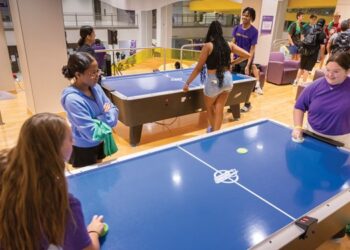There is no silver bullet to success when it comes to operating an amazing aquatics facility on campus. Instead it requires balancing great facilities with programming that is innovative, but also appeals to a wide variety of demographics.
The University of Akron began to see great success with its aquatic programming in 2004, when the Student Recreation and Wellness Center (SRWC) opened to students and the surrounding community. According to Nick Weber, the assistant director of aquatics, until the center’s opening, there had not been many “aquatic leisure” opportunities on campus.
“When the SRWC opened in 2004 however, it afforded us the opportunity to meet the needs of our population to a much greater degree,” recalled Weber. “With multiple pools, differing water temperatures, differing water depths, we can accommodate a lot more people with much better consistency. It is certainly not unusual — and really has become the norm — on a weekday evening for multiple swim teams, a diving team, a scuba diving program, a session of swim lessons, open rec swimmers and spa users to all be utilizing our facilities simultaneously.”
Although Weber explained having a leisure pool is great, he said having great programming pulls it all together and keeps participants coming back time after time. The University of Akron offers a large variety of programming opportunities, including scuba diving, swimming, informal open recreation and more. “The goal of the aquatics program is to accommodate a diverse set of participant needs, while providing a safe and inviting atmosphere,” said Weber. “Our programming goals differ by pool area, but we want to offer something that will engage users across a broad spectrum of ages and ability levels.”
At Colgate University in Hamilton, New York, aquatic programming is geared toward more than just youthful students. It has found success in catering a few programs to older adults within its local community as well, through the Chenango Water Exercise Group. The university partnered with Chenango, which rents pool space from the university, to host classes geared toward older adults and those with special exercise needs.
“We have about 130 people who belong to the group,” said April Cady, an administrator for Chenango. “We really push for people to come if they’ve had hip or knee replacements, people who have arthritis, or people who are overweight and can’t do anything but water exercise.”
While the local community benefits from having access to niche aquatic programming, Colgate University sees numerous advantages as well. “It keeps the pool in use, and having one of the nicer and bigger [aquatics] facilities within a good mile radius, it satisfies a need for keeping the community involved,” said Andy Waeger, the head swimming and diving coach at Colgate University.
However, swimming is not all fun and games. At Texas State University, garnering interest in aquatic programs — no matter the target age group — can be more difficult than garnering interest for club sports or group exercise programs, for example. “My opinion would be, being wet and having to completely dry off before class [is a challenge],” said Julie Saldiva, the assistant director of aquatics and safety at Texas State University. “When you get in the pool, you’re going to need more time to clean up.”
Due to the inconvenience factor, the aquatics department is striving to be creative with its programming in order to attract more participants. It recently purchased two water cycling bikes and is looking into purchasing inflatable water walking balls, which Saldiva believes would be of interest to students.
Weber explained the key to running a successful aquatics program involves diversity of programming and providing the options to make programs successful. “For example, a college student may not even know how to swim, but our leisure pool creates an inclusive environment that is welcoming and provides an opportunity for that non-swimmer to participate in aquatic activities,” he said. “On the flip side of that are the competitive athletes, who utilize our competition pool for the advantages it gives them in racing. The key to the operation is finding the balance in scheduling and program offerings in an attempt to keep everybody happy.”
To find that balance, Weber keeps an open mind. “We have a really collaborative mind set when it comes to programming and scheduling, and are open to trying new ideas as often as possible,” he said.










